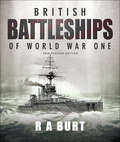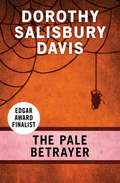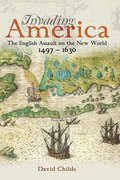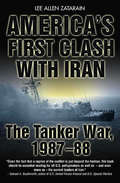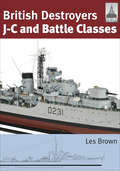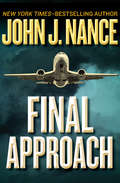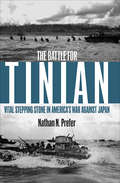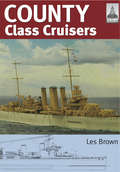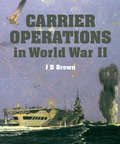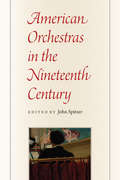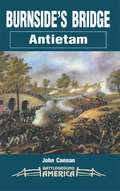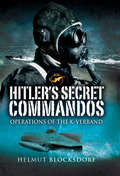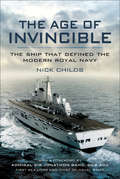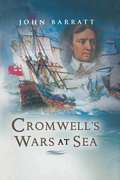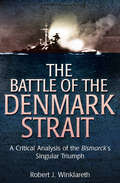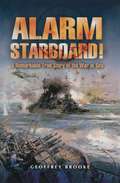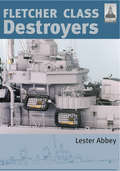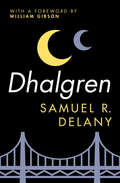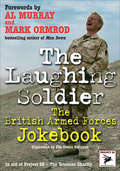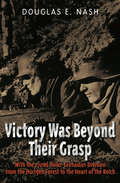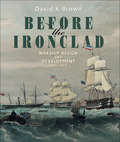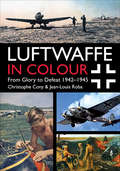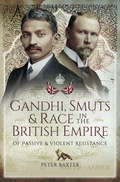- Table View
- List View
British Battleships of World War One: New Revised Edition
by R.A. BurtThe classic reference on the technical history of British capital ship design and construction during the dreadnought era. A century ago at Jutland, Dogger Bank, Heligoland Bight, and the first battle for the Falklands, mighty squadrons of these great armored ships fought their German counterparts for command of the seas. Beginning with Dreadnought, this book continues to the end of the First World War, and all of the fifty dreadnoughts, &“super-dreadnoughts,&” and battlecruisers that served the Royal Navy during this era are described and superbly illustrated with photographs and line drawings. Each class of ship is described in detail so that design origins, and technical and operational factors, are discussed alongside characteristics, with special emphasis on armament, armor, and machinery. Fully detailed data tables are included for every class, and more than 500 photographs and line drawings illustrate the text. A delight for the historian, enthusiast and ship modeler, this volume is regarded as an essential reference work for this most significant era in naval history and ship design.
Day of the Panzer: A Story of American Heroism and Sacrifice in Southern France
by Jeff Danby“[An] excellent popular history . . . a sprightly and evocative tribute to the troops of Operation Dragoon” (Publishers Weekly).This is a rarely detailed, “you are there” account of World War II combat, describing a brief but bloody tank/infantry action in August 1944. Based on six years of research—drawing from interviews, primary documents, and visits to the battlefield—The Day of the Panzer transports the reader into the ranks of L Company, 15th Regiment, Third Infantry Division, and its supporting M4s of the 756th Tank Battalion as they grapple head-on with the Wehrmacht.On August 15, 1944, L Company hit the beaches in southern France, joined by the tank crews of 2nd Lt. Andrew Orient’s 3rd Platoon, all veterans of Cassino. Despite logistical problems, the Third Division forged north through the Rhône River valley, L Company and its supporting tanks leading the regimental charge—until they faced a savage counterattack by the Germans and a rampaging Panther tank . . .In this book, the minute-by-minute confusion, thrill, and desperation of WWII combat is placed under a microscope, as if the readers themselves were participants. “Through his well-wrought prose, Danby paints a detailed picture of deadly fighting and stunning victory” (WWII History).“One of the most interesting and absorbing battles histories that this reviewer has ever read . . . remarkably realistic and personal.” —History Book Club“The excellent descriptions of infantrymen, tankers and supporting troops from the 15th’s Cannon Company using M8 self-propelled howitzers and the three inch gun armed M10s of the 601st Tank Destroyer Battalion make for good reading.” —War History Online
The Pale Betrayer
by Dorothy Salisbury DavisEdgar Award Finalist: Grand Master of crime fiction Dorothy Salisbury Davis delivers a thrilling tale of Cold War–era espionage and murder. One afternoon in Manhattan&’s Washington Square Park, Eric Mather is approached by two men, Tom and Jerry, with a business proposal: a bit of light espionage that may be considered treason. Eric&’s friend and colleague, physics professor Peter Bradley, is on his way back from an international conference in Athens. In his briefcase is a roll of film that must be confiscated to keep the Cold War from turning hot. Bradley won&’t miss this little roll of film, they say, and nobody will get hurt. When Bradley is stabbed to death in an apartment on East Tenth Street, Eric realizes he has made a bargain with the wrong people. Desperate to make up for betraying his friend, he ventures into a shadowy world of danger and intrigue as he sets out to learn everything he can about Tom and Jerry—two foreign agents engaged in an atomic game of cat and mouse.
Invading America: The English Assault on the New World, 1497–1630
by David ChildsA fascinating examination of why England failed for so long to colonize North America, in contrast to Spain’s rapid conquest farther south.Within a generation of Columbus’s first landfall in the Caribbean, Spain ruled an empire in central and south America many times the size of the home country. In stark contrast, after a century of struggle, and numerous disasters, English colonizing efforts farther north had succeeded in settling the banks of one waterway and the littoral of several bays. How and why progress was so slow and laborious is the central theme of this thought-provoking new book. Invading America argues that this is best understood if the development of the English colonies is seen as a protracted amphibious operation, governed by all the factors that traditionally make for success or failure in such endeavors—aspects such as proper reconnaissance, establishing a secure bridgehead, and timely reinforcement. It examines the vessels and the voyages, the unrealistic ambitions of their promoters, the nature of the conflict with the native Indians, and the lack of leadership and cooperation that was so essential for success. Using documentary evidence and vivid firsthand accounts, it describes from a new perspective the often tragic, sometimes heroic, attempts to settle on the American coast and suggests why these so often ended in failure. As this book shows, the emergence of a powerful United States was neither inevitable nor easily achieved.Includes illustrations and a list of historic sites
America's First Clash with Iran: The Tanker War, 1987–88
by Lee Allen ZatarainA revealing account of the US conflict with Iran over the Persian Gulf during the Reagan era—and the groundwork it set for today&’s tensions. In May 1987, the US frigate Stark was blown apart by an Iraqi jet fighter in the Persian Gulf, jumpstarting a major conflict with Iran that came to be known as the Tanker War. In America&’s First Clash with Iran, author Lee Allen Zatarain employs Pentagon documents and firsthand interviews to reveal the full story of a conflict that may have presaged further battles to come. At the climax of the Iran-Iraq War, Iran was losing on the battlefield. Ayatollah Khomeini decided to close the Persian Gulf against shipping from Iraq&’s oil-rich backer, the emirate of Kuwait. When the United States sent a fleet to the Gulf, raising the Stars and Stripes over Kuwait&’s commercial tankers, a tinderbox was set off. The Iranians laid mines throughout the narrow passage and launched attack boats against both tankers and US warships. The US Navy fought its largest surface battle since World War II against the Ayatollah&’s assault boats. As Saddam Hussein looked on, Iranian gunners fired missiles against US forces—actions which, if made known at the time, would have required the US Congress to declare war against Iran.
British Destroyers: J-c And Battle Classes (Shipcraft Ser. #21)
by Les Brown&“A terrific author . . . invaluable to the modeler wishing to reproduce these classes of destroyers, and also to those interested in naval history.&”—IPMS Magazine The ShipCraft series provides in-depth information about building and modifying model kits of famous warship types. Lavishly illustrated, each book takes the modeler through a brief history of the subject class, highlighting differences between sisterships and changes in their appearance over their careers. This includes paint schemes and camouflage, featuring color profiles and highly detailed line drawings and scale plans. The modeling section reviews the strengths and weaknesses of available kits, lists commercial accessory sets for super-detailing of the ships, and provides hints on modifying and improving the basic kit. This is followed by an extensive photographic survey of selected high-quality models in a variety of scales, and the book concludes with a section on research references—books, monographs, large-scale plans and relevant websites. A follow-up to ShipCraft 11 on inter-war destroyers, this new volume deals with the later classes which were the most modern British destroyers of the Second World War. Marked by a common single-funneled silhouette, they were actually very varied, ranging from the large and powerful J to N flotillas, via the austere &“War Emergency&” classes that were built in large numbers, to the radically different &“Battle&” class, designed with a powerful AA armament for service in the Pacific. &“This book will be of interest to those who want an easy reference book that covers the British and Australian destroyers of this period, especially with regard to camouflage and overall appearance in service.&”—Australian Naval Institute
Final Approach
by John J. NanceA government investigator looks into the cover-up of a deadly plane crash in this aviation thriller from the New York Times–bestselling author of Lockout. In the control tower at Kansas City International Airport, all the radar displays are red. But for the experienced pilots of North America Airlines, the thunderstorms aren&’t the problem: NAA has been cutting costs to stave off bankruptcy, and will do anything to keep their planes in the air. Unfortunately, no matter what they do, one is on its way down. After the aircraft collides with another plane on the Kansas City runway, in one of the worst aviation disasters of the decade, National Transportation Safety Board investigator Joe Wallingford arrives on the scene. As he studies the wreckage and pieces together the events that led to the tragedy, he realizes there&’s far more at play than pilot error or equipment malfunction. Wallingford will have to risk his career—and perhaps even his life—to solve the puzzle of the crash.
Sinister Weddings: Bride by Candlelight, Cat's Prey, and Bridge of Fear
by Dorothy EdenA special three-in-one edition by Dorothy Eden—featuring Bride by Candlelight, Cat&’s Prey, and Bridge of Fear—in which a bride-to-be, a wedding guest, and a recently married woman come face to face with evil as they innocently prepare to celebrate love Think well before you marry Paul Blaine.In Bride by Candlelight, this anonymous note is the prelude to a series of disturbing events plaguing Julia Paget. At an isolated New Zealand sheep-farming estate, she discovers that her war-scarred husband-to-be isn&’t the man she fell in love with three years earlier.In Cat&’s Prey, Antonia Webb journeys to a remote seaside resort in New Zealand to claim an inheritance and attend her cousin&’s wedding. And even the handsome solicitor who warns her away may not be able to protect Antonia from the evil closing around her.Is Abby Fearon paranoid—or is someone trying to kill her? In Bridge of Fear, this is the question she must answer. Abby arrives in the Australian outback from her native England to find that something has changed in her new husband . . . something that frightens her almost as much as the strange, wild land she now calls home.
The Battle for Tinian: Vital Stepping Stone in America's War Against Japan
by Nathan N. PreferThis vivid history chronicles the decisive US naval campaign that secured the Japanese island of Tinian—the site that would launch the end of WWII. In July 1944, the United States Navy and Marine Corps, Army, and Air Corps descended on the Pacific island of Saipan, just three miles away from the Japanese stronghold on the island of Tinian. There had been 20,000 Japanese troops on Saipan before the US unleashed a horrific all-arms campaign. The sudden silence indicated it was now Tinian&’s turn. When the battle for Tinian finally took place, the US acted with great skill. Historian Samuel Elliot Morrison called it &“the most perfectly executed amphibious operation of the entire war.&” Nevertheless, the Japanese shore batteries riddled the battleship Colorado, killing scores, and made multiple hits on a destroyer, killing its captain. On the island itself, the United States used napalm for the first time, paving the way for Marines rooting out strongpoints. One last banzai attack signaled the end to enemy resistance, as Marines fought toe-to-toe with their antagonists in the dark. After Tinian was secured, the United States built the biggest airport in the world there—home to hundreds of B-29 Superfortresses. Among these, just over a year later, were the Enola Gay and Bockscar, which, with their atomic bombs, would quickly bring the Japanese conflict, and the Second World War, to an end.
County Class Cruisers
by Les Brown&“A detailed look at British 10,000-ton Treaty Cruisers. &“A gem of research by the author, covering the design and progressive improvements to each ship.&”—Malcolm Wright, author of British and Commonwealth Warship Camouflage of WWII The ShipCraft series provides in-depth information about building and modifying model kits of famous warship types. Lavishly illustrated, each book takes the modeler through a brief history of the subject class, highlighting differences between sisterships and changes in their appearance over their careers. This includes paint schemes and camouflage, featuring color profiles and highly detailed line drawings and scale plans. The modeling section reviews the strengths and weaknesses of available kits, lists commercial accessory sets for super-detailing of the ships, and provides hints on modifying and improving the basic kit. This is followed by an extensive photographic gallery of selected high-quality models in a variety of scales, and the book concludes with a section on research references books, monographs, large-scale plans and relevant websites. This volume covers the British 10,000-ton Treaty Cruisers, thirteen of which were built to three slightly varying designs between the wars. With three funnels and a high freeboard, they were impressive ships, and all enjoyed very active wartime careers—three were involved in the Bismarck action and another with the sinking of the Scharnhorst. &“This book by Les Brown is rather like the Sci-Fi &‘Tardis&’ in that its outside belies the tremendous amount on the inside.&”—Malcolm Wright, author of British and Commonwealth Warship Camouflage of WWII
Carrier Operations in World War II
by J. D. BrownBetween 1939 and 1945 the Royal Navy's Fleet Air Arm grew from a small force into a powerful strategic weapon. British carrier-based aircraft fought throughout the world and David Brown here describes their activities in the Home, Mediterranean, Eastern and British Pacific Fleets, together with Forces created for specific operations, listing aircraft and units embarked during the various phases.He goes on to describe carrier operations in the Pacific between 1941 and 1945, the greatest maritime war in history. Both the United States and Imperial Japanese Navies watched the Royal Navy's early carrier operations in the European Theatre and benefited from the lessons. American aircrews and sailors learnt quickly in action until, by March 1945, the United States Fifth Fleet with its associated Marine Corps formations was probably the most efficient and effective instrument of war deployed in the pre-nuclear age.This new work contains material from two volumes, first published in 1968 and 1974, merged with notes for a third which David Brown prepared but never published before his death. They appear for the first time together, providing the most detailed single-volume account currently available of the operation of British, American and Japanese aircraft carriers in World War II.
American Orchestras in the Nineteenth Century
by John SpitzerStudies of concert life in nineteenth-century America have generally been limited to large orchestras and the programs we are familiar with today. But as this book reveals, audiences of that era enjoyed far more diverse musical experiences than this focus would suggest. To hear an orchestra, people were more likely to head to a beer garden, restaurant, or summer resort than to a concert hall. And what they heard weren’t just symphonic works—programs also included opera excerpts and arrangements, instrumental showpieces, comic numbers, and medleys of patriotic tunes.This book brings together musicologists and historians to investigate the many orchestras and programs that developed in nineteenth-century America. In addition to reflecting on the music that orchestras played and the socioeconomic aspects of building and maintaining orchestras, the book considers a wide range of topics, including audiences, entrepreneurs, concert arrangements, tours, and musicians’ unions. The authors also show that the period saw a massive influx of immigrant performers, the increasing ability of orchestras to travel across the nation, and the rising influence of women as listeners, patrons, and players. Painting a rich and detailed picture of nineteenth-century concert life, this collection will greatly broaden our understanding of America’s musical history.
Burnside's Bridge: Antietam (Battleground America Ser.)
by John CannonThe stone bridge on the southern flank of the Antietam battlefield became one of the Civil War's most powerful symbols of courage and sacrifice. Each stage of the battle is described by extracts from memoirs and diaries of the time, with details of the area as it was in 1862 and as it is today.
Hitler's Secret Commandos: Operations of the K-Verband
by Helmut BlocksdorfAn extensive history of the amphibious attack unit created by Nazi Germany during World War II.Hitler&’s Secret Commandos is the history of the K-Verband naval commando unit, established in 1943 to wreak havoc amongst invading allied forces involved in amphibious landings or actions, against German-occupied coasts. Following the Italian and British example, the basic idea was for a small, exceptionally well-trained and reliable commando force using the maximum element of surprise. Midget U-boats and small torpedo-carrying craft along the lines of the &“explosive boats&” used by the Italian Navy were designed for individual operations while a naval assault troop was formed for missions against important enemy operational targets near the sea after being landed from naval vessels offshore. Using German archive material, first-hand accounts and other published material this is the first comprehensive history of the K-Verband. It charts the development, structure, selection, training and equipment the Commando unit used together with a detailed narrative of the operations undertaken. The material has been translated from a German text, previously published in Germany with wide acclaim.
The Age of Invincible: The Ship that Defined the Modern Royal Navy
by Nick ChildsA gripping account of one of the Royal Navy&’s most significant modern warships. The HMS Invincible is a ship whose eventful life story, it is argued, embodies that of the Royal Navy itself during the second half of the 20th century and into the 21st. From her conception and design, through her various deployments (including the Falklands) and her evolving role and technical adaptation to meet changing strategic requirements, her fluctuating fortunes have been intertwined with those of the Royal Navy as a whole. Now, as a new breed of carriers is being commissioned to replace her, this thoroughly researched analysis of her career is the perfect platform from which to ask the important questions regarding the future role of the Royal Navy and Britain&’s place in the world.&“An exceptional story that integrates all various internal and external institutional forces that shape the life of a ship.&” —PowerShips
Cromwell's Wars at Sea
by John BarrattThe 200 years that separate the navy of Drake's day from that of Nelson were critical for the development of Britain's sea power, and the decade of the Commonwealth, of Cromwell's rule, is one of the turning points in the story. In the aftermath of a disastrous civil war and the execution of Charles I, the navy fought to defend the frail republic against the rivalry and hostility of other European nations and to extend British influence across the globe. In this fascinating reassessment of a decisive phase in the growth of British seapower, John Barratt shows how Cromwell's navy confronted the threats that came against it during a decade of almost continuous naval warfare, against the Royalists, the Dutch and the Spanish. At the same time he describes in detail the naval organization of the day and the rapid expansion of the service in the early 1650s, as well as the ships and the seamen who manned them.
The Battle of the Denmark Strait: A Critical Analysis of the Bismarck's Singular Triumph
by Robert WinklarethThis detailed analysis of the WWII naval battle by the acclaimed historian and mechanical engineer reveals new insight into the Bismarck&’s victory. In the spring of 1942, Nazi Germany unleashed its behemoth battleship Bismarck against the British in the Battle of the Denmark Strait. Bismarck destroyed the pride of the Royal Navy, HMS Hood, and severely damaged its newest battleship, HMS Prince of Whales. The decisive victory resonated both in Whitehall and Berlin—and yet there continues to be controversy as to how the conflict was actually fought. The Battle of the Denmark Strait offers a detailed technical analysis of combat circumstances, while new discoveries, revealed for the first time in this book, shed light on the battle. With a close examination of naval gunnery, from the various gun systems to the flight time of shells to their target, historian and mechanical engineer Robert Winklareth has painstakingly reconstructed the battle. He also explores events leading up to the titanic clash, as well as its aftermath.
Alarm Starboard!: A Remarkable True Story of the War at Sea
by Geoffrey Brooke&“Much more than a mere catalogue of a naval officer&’s experiences of war . . . All-in-all an excellent read and very highly recommended.&” —World Ship Society The author&’s naval war experiences make the most exciting reading. After being mined on the battleship Nelson in 1939, he served on the Prince of Wales, during the Bismarck action, witnessing the sinking of the Hood and Churchill and Roosevelt&’s historic meeting. He survived the disastrous sinking by Japanese dive-bombing in December 1941 but within two days of reaching Singapore, the Island fell. Evacuated in a coastal steamer, only to be sunk the next morning, he was stranded on a deserted island for a week before setting out for Ceylon in a native boat. His epic journey covered 1660 miles and took 37 days. Thereafter his adventures continued, with the North African landings, Russian convoys and, returning to the Far East. He was in the carrier Formidable when she was hit twice by Japanese Kamikazes before VJ Day August 1945.
Fletcher Class Destroyers (Shipcraft Ser.)
by Lester AbbeyThe 'ShipCraft' series provides in-depth information about building and modifying model kits of famous warship types. Lavishly illustrated, each book takes the modeller through a brief history of the subject class, using scale plans to highlight differences between sisterships and changes in their appearance over their careers, then moves to an extensive photographic survey of either a high-quality model or a surviving example of the ship. Hints on building the model, and on modifying and improving the basic kit, are followed by a section on paint schemes and camouflage, featuring numerous colour profiles and highly-detailed line drawings. The strengths and weaknesses of available kits of the ships are reviewed, and the book concludes with a section on research references—books, monographs, large-scale plans and relevant websites. The subject of this volume is the Fletcher class, often considered the most successful of all American destroyers. Built to the first design that was freed from treaty restrictions, they came into service near the beginning of the Pacific War and fought with distinction through all the most ferocious of the campaigns against Japan. They were constructed in large numbers, with a number of variations, and their popularity is reflected by the wide range of available kits.
Dhalgren (S. F. Masterworks Ser.)
by Samuel R. DelanyNebula Award Finalist: Reality unravels in a Midwestern town in this sci-fi epic by the acclaimed author of Babel-17. Includes a foreword by William Gibson. A young half–Native American known as the Kid has hitchhiked from Mexico to the midwestern city Bellona—only something is wrong there . . . In Bellona, the shattered city, a nameless cataclysm has left reality unhinged. Into this desperate metropolis steps the Kid, his fist wrapped in razor-sharp knives, to write, to love, to wound. So begins Dhalgren, Samuel R. Delany&’s masterwork, which in 1975 opened a new door for what science fiction could mean. A labyrinth of a novel, it raises questions about race, sexuality, identity, and art, but gives no easy answers, in a city that reshapes itself with each step you take . . . This ebook features an illustrated biography of Samuel R. Delany including rare images from his early career.
The Laughing Soldier: The British Armed Forces Jokebook
by Al Murray Mark OrmrodA witty collection that celebrates the strength to find humor even in the most challenging circumstances—with proceeds benefiting veterans.Britain’s armed forces have a legendary sense of humor, dating back over generations of servicemen and women. The Laughing Soldier, aiding the veterans’ charity Project 65, is a collection of jokes, along with messages of support for the troops, sent in by people all over the world. Contributors include serving personnel, veterans and their families, the general public, celebrities such as Alan Titchmarsh, comedian Milton Jones, and public officials including George Osborne, all inspired by the Armed Forces’ strength and capacity for finding humor in the toughest of situations.With forewords by satirist Al Murray, a.k.a. the Pub Landlord, and ex-marine Mark Ormrod, the Afghanistan hero who lost three limbs to a landmine and bestselling author of Man Down, and illustrated with cartoons by The Comic Stripper, The Laughing Soldier’s collection of jokes will lift the spirits of servicemembers and their families—and those who care about them.A donation is made to Project 65 from the sale of every book.
Victory Was Beyond Their Grasp: With the 272nd Volks-Grenadier Division from the Huertgen Forest to the Heart of the Reich
by Douglas E. Nash Sr.&“For both students of the German Army in World War II as well as those interested in the late 1944 campaign, this is a must-read&” (The NYMAS Review). As the Allies were approaching the German frontier at the beginning of September 1944, the German Armed Forces attempted to regain the strategic initiative. While the &“wonder weapons,&” such as the V-1 flying bomb, the V-2 missile, and the Messerschmitt Me-262 jet fighter, are widely recognized as being the most prominent of these initiatives upon which Germany pinned so much hope, the Volks-Grenadier Divisions (VGDs) are practically unknown. Often confused with the Volkssturm, the Home Guard militia, VGDs have suffered an undeserved reputation as second-rate formations filled with young boys and old men suited to serve only as cannon fodder. This groundbreaking book, now in a new edition, shows that VGDs were actually conceived as a new, elite corps loyal to the National Socialist Party composed of men from all branches of Hitler&’s Wehrmacht and equipped with the finest ground combat weapons available. Whether fighting from defensive positions or spearheading offensives such as the Battle of the Bulge, VGDs initially gave a good account of themselves in battle. Using previously unpublished unit records, Allied intelligence and interrogation reports, and, above all, interviews with survivors, the author has crafted an in-depth look at a late-war German infantry company, including many photographs from the veterans themselves. In this book we follow along with the men of the 272nd VGD&’s Fusilier Company from their first battles in the Hürtgen Forest to their final defeat in the Harz Mountains. Along the way, we learn the enormous potential of VGDs—and feel their soldiers&’ heartbreak at their failure.
Before the Ironclad: Warship Design and Development, 1815–1860
by David K. BrownIn the massive revolution that affected warship design between Waterloo and the Warrior, the Royal Navy was traditionally depicted as fiercely resisting every change until it was almost too late, but these old assumptions were first challenged in this authoritative history of the transition from sail to steam. Originally published in 1990, it began a process of revaluation which has produced a more positive assessment of the British contribution to the naval developments of the period. This classic work is here reprinted in an entirely new edition, with more extensive illustration.Beginning with the structural innovations of Robert Seppings, the book traces the gradual introduction of more scientific methods and the advent of steam and the paddle fighting ship, iron hulls and screw propulsion. It analyses the performance of the fleet in the war with Russia (18531856), and concludes with the design of the Warrior, the first iron-hulled, seagoing capital ship in the world. The author presents a picture of an organisation that was well aware of new technology, carefully evaluating its practical advantage, and occasionally (as with its enthusiastic espousal of iron hulls) moving too quickly for the good of the service. Written by an eminent naval architect, Before the Ironclad is both a balanced account of general developments, and an in-depth study of the ships themselves.
Luftwaffe in Colour: From Glory to Defeat
by Christophe Cony Jean-Louis RobaNearly four hundred photos documenting the last years of the Luftwaffe: &“If you&’re interested in unit history then this book is a must have&” (Britmodeller.com). A companion to the first volume of Luftwaffe in Colour, which covered the victory years from 1939 to Spring 1942, this book contains even more fascinating material on the machines of the Luftwaffe and the men who flew them as their fate took an increasingly grim path. Initially, the Luftwaffe ruled the skies, but eventually, they fought an increasingly futile war of attrition that, when combined with vital strategic mistakes in aircraft production, was its death knell. Despite this, the Luftwaffe produced the most successful air aces of all time. Among many remarkable images, we see one of the last Junkers 87 B-2 operational on the Eastern Front during the winter of 1942-1943; the huge BV 222 V-5 of Lufttransportstaffel in the port of Heraklion in late 1942; pilots in Tunisia in 1943; the aces Hans Philipp, Wolfgang Späte, and Heinz Schnaufer; and a vivid demonstration of the reversal in fortunes in 1944 as Allied bombers destroy 106 sites, engulfing them in fire at Schwäbisch Hall on German soil. In this painstakingly curated collection, the full detail behind the propaganda is once more revealed in rare color photographs.
Gandhi, Smuts & Race in the British Empire: Of Passive & Violent Resistance
by Peter BaxterTowards the end of 1906, a meeting took place between two emerging giants of the age, Mohandas K. Gandhi and General Jan Christian Smuts. United under the same empire, but separated by distance and culture, Smuts was born in the Cape Colony, and Gandhi in Porbandar, a duchy of the Indian province of Gujarat. Both, however, went on to study law in Britain, and while developing a great admiration for the institutions of empire, each man also suffered his own particular crisis of faith. From their widely dispersed origins, Gandhi and Smuts collided over the issue of race and equality in a turbulent province of the empire, each attempting to hold the British to their stated ideals. This insightful book explores attitudes to race, and belonging, in an age when the English speaking peoples straddled the globe, and sought to impose on all of their subject races, basking under the radiance of Britannia, a common ideal of parity, equal opportunity and free movement.
